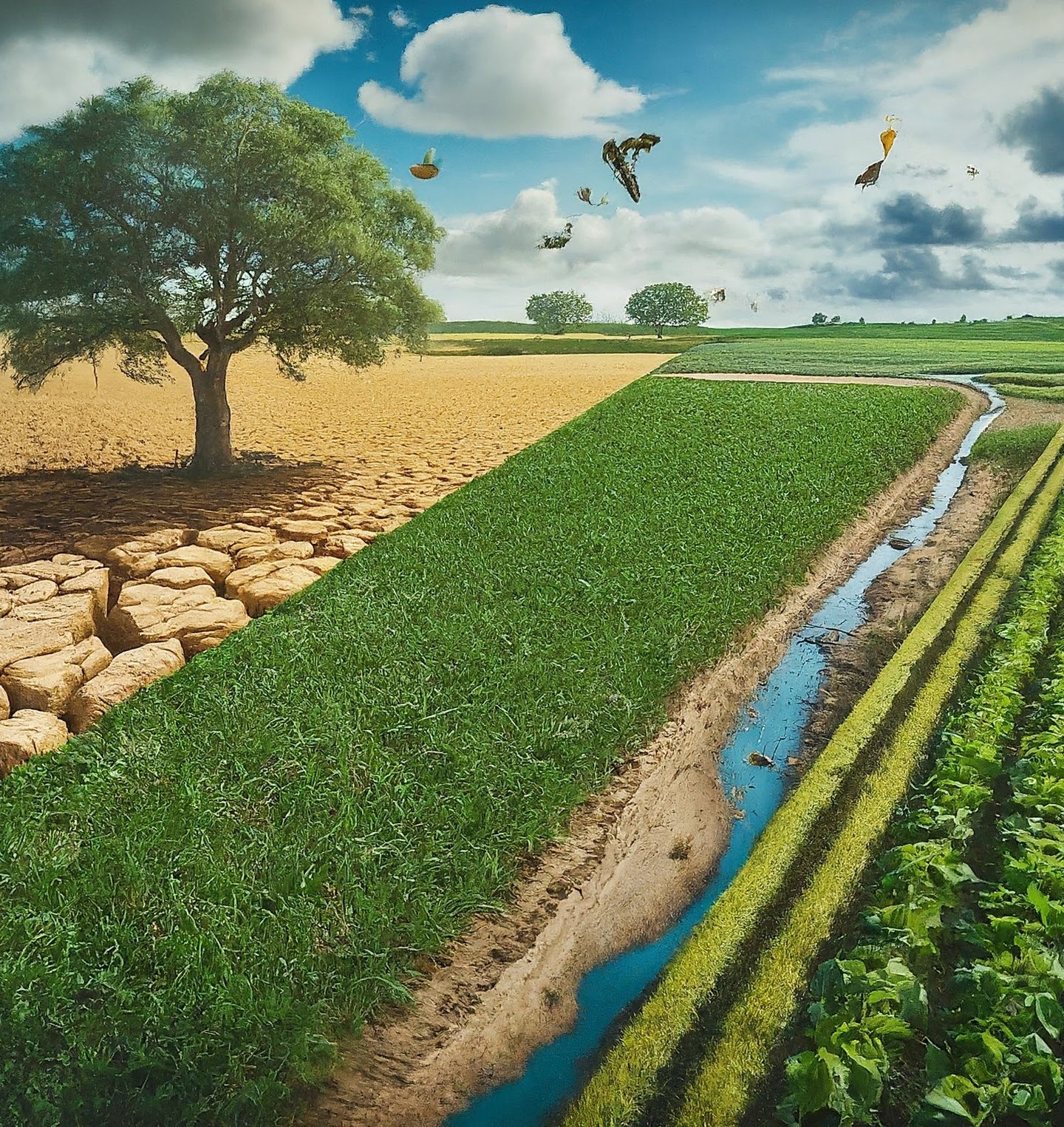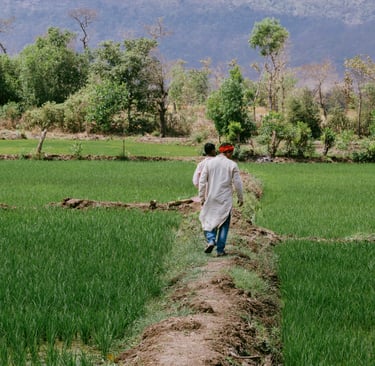How a Weak Ecosystem Mars the Chances of Climate-Resilient Farming
ECONOMIC VISION
7/7/20244 min read


PIC: GEMINI AI


Institute of the Happy Planet
In the face of escalating climate change, the need for climate-resilient farming has become more pressing than ever. However, the success of such initiatives is often undermined by weak agricultural ecosystems. This write-up explores the multifaceted ways in which fragile agricultural ecosystems hinder the transition to climate-resilient agriculture, drawing on examples and initiatives from India and beyond.
Understanding Agricultural Ecosystems
An agricultural ecosystem encompasses the interactions among all living organisms (plants, animals, and microbes) and their physical environment within a farming system. This includes soil health, water availability, biodiversity, and the socio-economic structures that support farming practices. A robust agricultural ecosystem provides essential services such as nutrient cycling, pest control, pollination, and water regulation, all of which are crucial for sustainable farming.
The Importance of Climate-Resilient Farming
Climate-resilient farming involves adopting practices and technologies that enable agricultural systems to withstand and recover from climate-related stresses such as droughts, floods, and temperature extremes. It includes the cultivation of stress-tolerant crop varieties, efficient water management, soil health improvement, and the integration of sustainable practices like crop rotation and agroforestry.
A robust agricultural ecosystem supports these practices by providing essential services. Conversely, a weakened ecosystem cannot support sustainable agriculture, leading to reduced productivity and increased vulnerability to climate impacts.
Water Scarcity and Mismanagement
One of the primary challenges in climate-resilient farming is water management. Regions with degraded agricultural ecosystems often suffer from poor water retention and availability. For instance, in India, water-intensive crops like rice and sugarcane dominate agriculture, exacerbating water scarcity in already drought-prone areas. Initiatives to promote less water-intensive crops are often hampered by inadequate water conservation infrastructure and practices.
A weak agricultural ecosystem, characterized by deforestation and soil degradation, further diminishes the land's ability to retain water. This results in reduced groundwater recharge and increased surface runoff, making farming communities more vulnerable to droughts. Effective water management practices, such as rainwater harvesting and efficient irrigation systems, are essential but difficult to implement without a healthy ecosystem.
Soil Health and Fertility
Soil health is a critical component of climate-resilient farming. Healthy soils are rich in organic matter, retain moisture better, and support diverse microbial communities that enhance nutrient availability. However, degraded agricultural ecosystems suffer from soil erosion, nutrient depletion, and acidification, which reduce agricultural productivity and resilience.
For example, the rice fallow initiative in Odisha, India, aims to utilize residual soil moisture for growing pulses and oilseeds post-rice harvest. While this practice can enhance land use efficiency and income, its success is contingent on maintaining soil health. In regions with degraded soils, additional measures such as the application of bio-fertilizers and soil amendments like dolomitic limestone are necessary to restore fertility and support sustainable crop production.
Biodiversity and Pest Management
Biodiversity plays a crucial role in pest management and ecosystem stability. Diverse farming systems that include a variety of crops and livestock are less susceptible to pest outbreaks and diseases, reducing the need for chemical pesticides. However, weak agricultural ecosystems often lack the biodiversity needed to support natural pest control mechanisms.
In areas with monoculture farming, the reliance on chemical pesticides can lead to pest resistance, soil degradation, and water contamination, further weakening the ecosystem. Initiatives like the Krishi Mangal accelerator in India highlight the importance of integrating biodiversity and ecosystem health into agricultural innovation. Krishi Mangal supports agri-tech startups that focus on sustainable practices and technological advancements in soil testing, water management, and crop management. These startups provide critical support to small and marginal farmers, helping them adopt climate-resilient practices and improving their livelihoods.
Who We Are:
The Economic Nations champions global unity through economic collaboration, focusing on sustainable growth, reducing inequalities, and enhancing global relationships for mutual prosperity and peace.
________________________________________
Economic and Social Dimensions
The transition to climate-resilient farming is not solely a technical challenge; it also involves significant economic and social considerations. Farmers need access to financial resources, markets, and education to adopt new practices and technologies. In weak agricultural ecosystems, these resources are often limited, exacerbating the challenges faced by smallholder farmers.
For instance, the Indian government's plan to promote climate-resilient agriculture in 50,000 villages involves the distribution of stress-tolerant crop varieties and the establishment of a voluntary carbon market for sustainable practices. However, the success of such initiatives depends on building the capacity of farmers, providing access to eco-friendly inputs, and creating supportive policies and market linkages.
Policy and Governance Challenges
Effective policy and governance frameworks are essential for fostering climate-resilient farming. Policies need to incentivize sustainable practices, support research and development, and facilitate knowledge transfer among farmers. However, weak agricultural ecosystems often coincide with weak governance structures, making it difficult to implement and enforce such policies.
The political economy of agricultural policy reform, as seen in various global contexts, underscores the complexity of aligning stakeholder interests and overcoming resistance to change. For example, India's market reforms during peak COVID-19 times aimed at reducing government intervention in agriculture faced significant opposition from farmers and state governments, highlighting the need for inclusive and participatory policy processes.
Conclusion
The path to climate-resilient farming is fraught with challenges, particularly in regions with weak agricultural ecosystems. Water scarcity, soil degradation, biodiversity loss, and socio-economic constraints all contribute to the difficulty of implementing sustainable agricultural practices. Addressing these challenges requires a holistic approach that integrates ecological restoration, technological innovation, economic support, and effective governance.
By strengthening agricultural ecosystems, promoting sustainable practices, and supporting farmers through education and resources, it is possible to build more resilient agricultural systems. The examples from India and other regions demonstrate both the potential and the complexities of this endeavor, underscoring the need for continued research, investment, and collaboration in the pursuit of climate-resilient farming.
PIC: CANVA
Contacts
enquiry@economicnations.org
(xx) 98-11-937-xxx (On verification)
